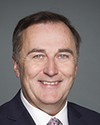Thank you.
Mr. Ellis, welcome to the defence committee. You have the floor.
Evidence of meeting #39 for National Defence in the 42nd Parliament, 1st session. (The original version is on Parliament’s site, as are the minutes.) The winning word was mefloquine.
A recording is available from Parliament.
Liberal

The Chair Liberal Stephen Fuhr
Thank you.
Mr. Ellis, welcome to the defence committee. You have the floor.
February 23rd, 2017 / 4:30 p.m.
Liberal

Neil Ellis Liberal Bay of Quinte, ON
There was a question asked about comparisons with other military forces, and your answer was no. I just wondered when I looked at the statistics. You said, I think, that marriage and debt were the number one and number two contributing factors.
Have you even looked at what other countries do in order to try to alleviate those stressors through comparable programs? You're saying in your notes that the number one cause is marriage. The other one was debt, and I think the third one was prescription drugs or....
BGen Hugh MacKay
We haven't looked at this particularly from a health services perspective, but I know that within military personnel command they have close relationships with other military and look at the programs they have in place to help address the kinds of stressors that go on in military life.
Col Andrew Downes
Our 2009 expert panel specifically looked at the U.S. Air Force program, which is one of the few programs that actually showed a reduction in suicide rate. Even at that time, we had nearly all of the components of that program. We've included some of the others and done other things as well to enhance what we currently do for people.
Liberal

Neil Ellis Liberal Bay of Quinte, ON
Okay.
I'll go back to the mefloquine question.
You testified in the VAC committee, and I think you were asked about the percentage of the affected population it would have side effects on. I think the statistic was about 2%, off the top of my head. Does that number include the side effects for people who actually shouldn't take it? I don't know if I'm trying to pull that from your testimony.
I can just ask you that question, I guess. On the side effects, what's the percentage...?
BGen Hugh MacKay
There are different side effects.
One of the numbers that I spoke to was a number related to significant neuropsychiatric side effects and prolonged neuropsychiatric side effects. The number that we have is somewhere between one in 10,000 and one in 12,000 who may have that significant neuropsychiatric side effect.
We know a greater percentage of people have other, lesser side effects that are short-term types of side effects, whether it's some dreams associated with taking the medication or not. I don't have that number in my memory right now, but it is far more than the one in 10,000.
Liberal

Neil Ellis Liberal Bay of Quinte, ON
Okay.
An interesting part of the stressors had to do with legal aspects and debt. Do we offer any type of counselling or programs in that suite to families and to the men and women who do serve?
BGen Hugh MacKay
Yes, we've always had a program for those who get into financial difficulty to have the opportunity to seek financial counselling through our SISIP financial counselling program.
When it comes to legal problems, we've identified one thing that is really important. When we know someone has gotten into some legal difficulty, there is a handover of that person to their chain of command so that the chain of command is aware and they aren't able to go off on their own. Then, of course, they are able to seek assistance through assisting officers within their units.
Liberal

Neil Ellis Liberal Bay of Quinte, ON
I guess the other correlation is age. You have it in a graph here. Since you tracked that, I looked at the dates and I think it's more towards the younger end of our military. The numbers were higher in that range.
Is there anything geared towards prevention in that age group? If we're chasing something and it's more prevalent at the age of 21 or 22, as I think I read in your notes, are we targeting that area more than towards the age 40 range?
Col Andrew Downes
Suicide in 15- to 34-year-olds in Canada is the second leading cause of death in males. We're talking about the young military male population group of people. Suicide is a very common phenomenon in terms of cause of death.
We haven't specifically targeted them based on age, but as we've discussed, we do have mental health education programs right from the second week of basic training. We have a communications plan every year that includes messaging that we send out through tweets and email. We run campaigns. We have an annual addictions campaign. We participate in Bell Let's Talk. We participate in Mental Illness Awareness Week, World Suicide Prevention Day, and so on.
We have a suite of things that we provide to try to communicate down to all members of the Canadian Forces about mental health, the issue of suicide, care-seeking, and staying in care.
Col Andrew Downes
Thank you, sir. I haven't mentioned apps.
We are working on a road to mental readiness app that we're hoping now will be ready for launch in May. We're hoping that appeals to young members of the Canadian Forces.
Liberal

The Chair Liberal Stephen Fuhr
You're out of time.
We're going to be able to go around the track one more time for sure. I'm going to give the last formal question to Mr. Garrison.
You have the floor.
NDP
Liberal

The Chair Liberal Stephen Fuhr
Do you want to pass it back to Mr. Ellis? He can continue for three minutes.
Liberal

Neil Ellis Liberal Bay of Quinte, ON
Going back to your app, I know some of the municipalities and the provincial level are offering a wind-down or a chat after a traumatic incident, whether it's an ambulance driver or whether it's a firefighter. Some of these programs are actually homegrown in municipalities and counties.
After a deployment—it doesn't even necessarily have to be a deployment, but could be an accident at a base and somebody has to clean up the aftermath or see it—are we doing prevention that way and putting any resources or money or anything in the way of a program or a wind-down after these events?
I know a lot of fire and ambulance services are doing that on a regular basis. Have you explored that, or do you have that process?
Col Andrew Downes
We have that. We call it an “ad hoc incident review”. After a potentially traumatic incident there will be a discussion of the event led by the chain of command and an opportunity for people to speak about it, and information is shared with them about where to go for care should care be required. It's a formalized part of the road to mental readiness program.
Col Andrew Downes
It's at the discretion of the leadership of the organization to decide when it's appropriate to do that. In some incidents it would be very obvious to do, but then there might be some incidents where the leadership and members of the unit would have a sense as to whether something such as that is necessary. However, at all times people are invited to come forward for care, because they might have been exposed to a traumatic incident outside the workplace.
Keeping the door open and encouraging people to seek care for any type of mental health problem is really the way to go, because we treat all mental health issues, not just those related to work.
Liberal

Neil Ellis Liberal Bay of Quinte, ON
Lastly, if it does happen, what's available to the family afterward? If there is a suicide of a member, what's the follow-up for the mental health of the whole gamut and the men and women who surround that person?
Col Andrew Downes
We call that “postvention”. It's sort of an official part of what we do when there's been a suicide. We don't provide health care to the families, of course—they would need to see their own medical care providers for that—but we do offer some support programs.
Our CFMAP program, which is our equivalent to the EAP program, does offer a bereavement service to family members for whatever reason. There's also another program called the HOPE program, which also offers bereavement services. We also have chaplains that do bereavement care as well.
There are a number of things in place to help people who are going through the grief when there's been a suicide. Within the military community, we pay attention to people in units, to colleagues, and also to the care providers as well, because care providers can carry a lot of guilt. After there's been a suicide, they wonder what they could have done differently.
Liberal

The Chair Liberal Stephen Fuhr
That's the last of the time for the structured questions. I see there's still a will to carry on, so I'm going to go around the track one more time with five-minute questions.
I'm going to yield the floor first to the Liberals' Ms. Alleslev. Then I'll go over to Mr. Bezan, and then Mr. Garrison wants an opportunity. He can have the last five-minute question, but I'll re-evaluate as time permits.
Ms. Alleslev, you have the floor.
Liberal

Leona Alleslev Liberal Aurora—Oak Ridges—Richmond Hill, ON
Thank you.
I noticed from the document that 28% of the incidents of suicide have experienced legal or disciplinary procedures. Could you shed some light on what, perhaps, is being done to bridge that gap or link with the judicial system? Is the judicial system being educated on the issues around mental health and in using that as a defence? I noticed there wasn't a recommendation related to increased communication with the judicial system on these types of topics.
BGen Hugh MacKay
I don't believe we've had any engagement with the judicial system, although we have worked, and do work, with the military police with respect to the handoff policy that I referred to earlier.
Usually the incident or the stress that we're talking about isn't a result of a court appearance. It's the result of a charge that's been laid by the military police.